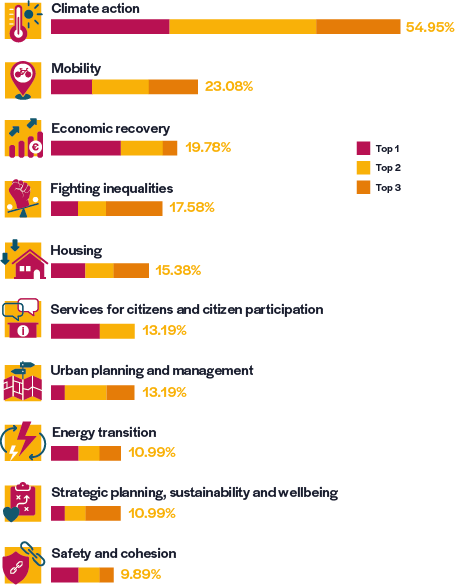Reading Time: 8 minutes
Climate neutrality – getting started for a mission
Cities are targeting diverse climate actions, both locally and in their interactions with other cities and levels of government. Through initiatives such as the European Commission’s Mission for 100 Climate Neutral and Smart Cities by 2030, cities are inspiring new and effective ways to reduce emissions.
Cities are targeting diverse climate actions, both locally and in their interactions with other cities and levels of government. Through initiatives such as the European Commission’s Mission for 100 Climate Neutral and Smart Cities by 2030, cities are inspiring new and effective ways to reduce emissions.
As demonstrated in the results of the Eurocities Pulse Mayors Survey, becoming climate neutral is at the top of cities’ priorities for the coming years. This has been a consistent trend of city ambitions in recent years, with many initiatives created to help cities get there. A 2021 survey by Eurocities, for instance, showed that 74% of cities already had plans in place to reach climate neutrality by or before 2050.
All over Europe, there are examples of cities that have taken great leaps towards meeting the targets of climate agreements set by international agendas such as the European Green Deal. At the same time, given the complex nature of this challenge, and need for systemic change, cities have to overcome many structural, cultural and institutional barriers, and not all cities have the same capacity.
Increasingly, cities have sought to shift towards a culture of greater participation to meet this challenge, realising that the input of diverse stakeholders is paramount and that they have a role in cutting their own emissions and encouraging behaviour change. In this spirit, cities are beginning to see themselves as the leaders that will drive this change, and they are reaching out to national governments, to businesses, to academia, to local people, and to other cities to find structured, and collaborative, ways to learn from others and to implement impactful change.

Eurocities Pulse 2023
Alongside NetZeroCities, Eurocities is involved in other projects related to the Mission, such as UPPER (Unleashing the Potential of Public Transport in Europe), which aims to strengthen the role of public transport as the cornerstone of sustainable and innovative mobility. The project will implement a combination of measures looking to push people out of private car use and to pull them closer to public transport in cities across Europe.
What will it take?
In part, the impetus for the ‘Missions’ concept is to do things that are hard, or difficult to define – modelled on the infamous ‘moonshot’ challenge of US President John F. Kennedy. For example, no investment plan of the scope intended in the Climate City Contracts – a city-wide portfolio planning for blended public-private financing towards a common goal – currently exists. As such, if these models can be made to work, it will not only offer a new governance approach for transformative change, but will be a hook to enable changes to take place in other institutions and at other levels of government.
Developing a comprehensive city plan also entails thinking outside of the more siloed approach traditionally taken by individual city departments, and developing better coordination with, and support from, the national and regional level. One area where this is important is taking into account the carbon content of the electricity grid. While this is usually a national competence, and therefore not something cities have direct influence on, it has a huge impact on how well cities can achieve climate neutrality objectives. Another area can be cities with large and strategic national infrastructure within their territory, such as a port. For example, Rotterdam has the largest seaport in Europe, accountable for around 15% of the total carbon emissions of the Netherlands, and with an administration that goes beyond the local authority.
As such, combined work with different levels of governance is critical to the success of the Mission, given that city administrations often have direct control or influence over less than half of the emissions produced within their territory. The importance of national regulation to speed up the transition, in areas like the emissions from buildings, transport and roads, through fiscal incentives and green taxation cannot be overstated.
71 Eurocities members were selected for the 100 Climate-Neutral and Smart Cities Mission
Mayors Alliance for the European Green Deal
– a demonstration of political will
Cities are critical places in accelerating the energy transition and key partners in accomplishing the EU’s climate goals. In their political role, mayors act as ambassadors in different directions: for example, to represent residents and their concrete needs to European and national decision makers; and to explain the benefits of European solidarity and collaboration at the local level. The Mayors Alliance for the European Green Deal, created in 2021 as an initiative of Eurocities, demonstrates that a sustainable transition is possible and showcases how cities are taking the lead in creating win-win city visions where the different elements of sustainability, environmental, social and economic policy, are mutually reinforcing.
As highlighted in the guest essay by European Commissioner Kadri Simson, with its REPowerEU initiative, launched very quickly after the Russian invasion of Ukraine, “the European Union came out with a decisive plan to respond to the energy challenges and to accelerate the EU’s clean energy transition.”
These proposals built on initiatives that were already making their way through the EU’s legislative cycle. The FitFor55 package – which sets the EU’s legislative agenda for cutting emissions by 55% by the end of the decade – is chief among these, and has been a main focus of the Mayors Alliance action to date. For instance, REPowerEU will boost the binding energy efficiency target from 9 to 13%. Similarly, the announcement on renewable energy production lifts the FitFor55 target of over 1,000GW to somewhere over 1,200GW per annum in the EU.
One highlight of REPowerEU’s focus on accelerating the energy transition is to double solar photovoltaic capacity in the EU by 2025 and install 600GW by 2030. This includes a Solar Rooftop Initiative with a phased-in legal obligation to install solar panels on new public and commercial buildings and new residential buildings. This is strongly supported by Eurocities, and reflected in mayors’ responses to the Eurocities Pulse survey as regards their investment priorities and how they believe the EU can best support them.
Two key areas for cities in the FitFor55 package have been the revision to the Energy Performance of Buildings Directive, and the Efficient & Green Mobility Package.

Green mobility
Given that over 74% of urban residents are still exposed to harmful levels of air pollutants at concentration levels above the recommended World Health Organisation guidelines, the EU Efficient & Green Mobility Package is well placed to help cities introduce safer, more sustainable and affordable mobility options. In Spring 2023, after intense diplomatic negotiations, and Eurocities mobilisation of many German mayors in favour of the proposal, as a counterweight to the national position, the Council of the European Union endorsed a regulation that will lead to the phase out of internal combustion engines by 2035.
Through its work in the Mayors Alliance, Eurocities welcomed the deal as a signal that the legislation banning the sale of petrol and diesel cars may soon be finalised. A phase out by 2035 at the latest is a clear precondition for readying the road transport sector and reaching the EU’s legally binding objective of climate neutrality by 2050, given that new vehicles frequently stay on EU roads for more than 15 years after their sale.
Another essential step in transitioning away from petrol and diesel cars will be ensuring that adequate charging infrastructures exists across our road networks, which is part of a wider legislative effort to revise the Alternative Fuels Infrastructure Regulation. Already, many cities such as Amsterdam are -free mobility.
Clean vehicles are essential to achieving the goals of the Green Deal – not least in cities.
– Burkhard Jung, Mayor of Leipzig
Energy efficient buildings
Given that buildings account for 40% of final energy consumption in the European Union and 36% of its energy-related greenhouse gas emissions, the revision of the EU’s Energy Performance of Buildings Directive has the potential to improve energy efficiency, reduce energy poverty by prioritising measures for the worst performing buildings and vulnerable households, and increase the wellbeing of residents through better buildings.
Ratified by the European Parliament in March 2023, first up on the list of priorities for cities was establishing a clear roadmap to achieving the proposed target of 3% renovation per year, by introducing a European framework for the Minimum Energy Performance Standard of buildings. Cities can channel support, ensure uptake of solutions, inform the supply chain about skills and investment needs, and collect local data on which the standards are based. Therefore, the introduction of an obligation for EU member states to provide a robust financial and technical framework for implementing these standards has been welcomed by local leaders to ensure that cities can fulfil this key role.
A strong component of the Fit For 55 package from the start has been its focus on mainstreaming social equity. A commitment to establish at least 1 one-stop shop per 45,000 inhabitants will go a long way to ensuring everyone has access to trusted advice on renovations. In addition, EU member states are now requested to make financial incentives eligible for tenants and housing cooperatives. In light of the pressures on rental costs in many cities across Europe, the agreement also underlines that costs for tenants should stay affordable after renovations.
